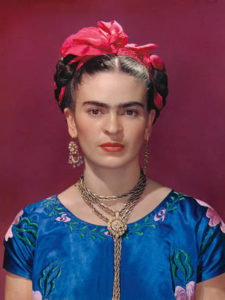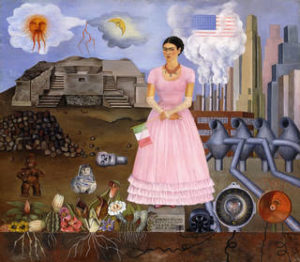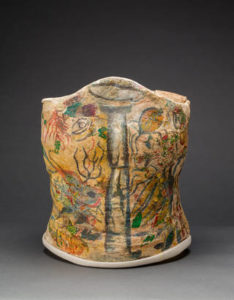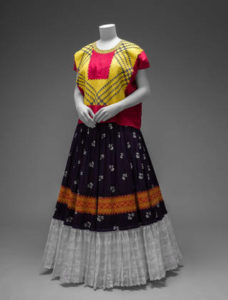 The V & A’s summer exhibition is not a large one and it has received mixed reviews since it opened earlier this month. Last week I went along to see for myself.
The V & A’s summer exhibition is not a large one and it has received mixed reviews since it opened earlier this month. Last week I went along to see for myself.
My knowledge of Frida Kahlo was limited – a twentieth century Mexican painter whose art found inspiration in her own life, married to fellow artist Diego Rivera and part of the Mexicayotl or Mexican artistic revolution which sought to define an identity for Mexican art. So far so Wikipedia. I had seen images of some of her self portraits and knew of her distinctive look, the mono-brow, the traditional garments and the naif style, a sort of magic realism. But little else.
This exhibition was just what I needed, an illustrated journey from her birth, to Germano-Mexican parents, childhood infirmity ( she contracted polio aged 6 ) and the subsequent tragic accident that left her ill and in pain for the rest of her life; the marriage to Diego Rivera, communist period, divorce, reconciliation, extending the Blue House (her home where she and Rivera lived) and her travels with her husband to the United States and Europe where she wowed Andre Breton  and Paris.
and Paris.
It has been criticised for not containing many paintings and it’s true, it doesn’t. But I don’t think that’s what it is about, it is more about the individual and how, in part because of her infirmities and in part because it was simply part of her personality and beliefs, she manufactured a Frida Kahlo for public consumption. This Frida Kahlo became an artwork in herself. Hence the exhibition’s title ‘Frida Kahlo: Making Herself Up’.
The self-portraits, the photographs (her father was a photographer) the films, all show her contrivance. Everything is posed. Even when she is filmed showing Trotsky and his wife around the Blue House, she is camera aware to a degree  that her famous guest is not. It is also true that, when one sees the surgical supports she was forced to wear because of her spinal injuries, corsets of metal and leather, one realises how her ‘natural’ movement must have been curtailed. Whether she wished it or not she was and would always be ‘posed’.
that her famous guest is not. It is also true that, when one sees the surgical supports she was forced to wear because of her spinal injuries, corsets of metal and leather, one realises how her ‘natural’ movement must have been curtailed. Whether she wished it or not she was and would always be ‘posed’.
This exhibition made me realise just how much her disability determined, in large measure, what her public image was. The corsetry and other supports meant that tight clothes would not have been flattering so she chose the traditional native Mexican peasant clothes like huipils, rebozos and ruffled skirts which hid the distorted form. This matched with her commitment to the identity of Mexico and her mestiza ancestry. There are a lot of clothes and jewellery in the exhibition which I found interesting (and, sometimes, very lovely ). Yet the most touching item was one of her rigid plaster corsets which she decorated with imagery of Mexico and herself. This was a woman who would not allow her physical disabilities to define  who she was.
who she was.
That is the essence of what this exhibition taught me – about Kahlo’s resilience, her determination not to be cowed by her circumstances. Now I want to see more of her art.
The exhibition runs until 4th November 2018 at the V & A, it is well worth a visit, though you will need to purchase timed tickets, it’s very popular, especially with women. Tickets cost £15 (£12 concessions).
For more on art exhibitions why not try The Jameel Prize Lin Mae Saeed – Bees Picasso 1932


 RSS – Posts
RSS – Posts